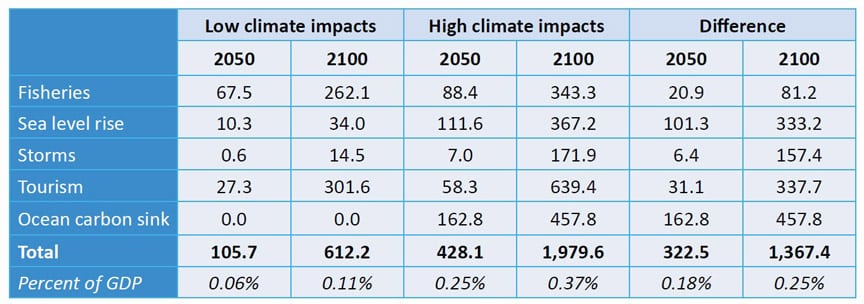Excerpt from the Draft Executive Summary of
Valuing the Oceans, a book to be published later this year
by the Stockholm Environment Institute
Uniting an analysis of the ways multiple threats interact in the ocean with a global economic analysis of the comparative consequences of action or inaction on global environmental change, and in particular climate change, is a major and ongoing challenge.
While there is no universally accepted definition of the “blue economy,” the goal of strengthening it is widely considered to require that we integrate and make sustainable all sectors and functions that rely on marine resources and ecosystems, allowing them to continue to provide their vital and irreplaceable services.
Some things are too valuable to be assigned meaningful prices. Rather than asking the impossible question of what the ocean itself is worth, what this chapter seeks to at least partially calculate is “what is the value of preventing further damage to the ocean?”
Or, “what is the cost of the environmental damage that could be done to the ocean if we do not take action?”
The analysis is restricted to five categories of damages that can be meaningfully priced and that can realistically be affected by policy decisions taken today and in the coming decades. The difference in climate impacts is measured between two scenarios:
- a scenario of only limited, slow-moving abatement, where emissions continue to grow for many decades; and
- a rapid abatement scenario, where emissions are reduced quickly and effectively, starting at once and approaching zero within this century.
The best estimates, based on the most reliable and up-to-date analyses available, of the “price” of the five categories of damages discussed here are presented in the table below
By 2050, the value of these important climate impacts is estimated to be more than four times higher under a high emissions, high impact scenario.
By 2100, the cost of damage if we follow the high emission pathway rises to USD 1,980 billion, equivalent to 0.37 percent of global GDP.
The difference between the two scenarios, or the amount that can be saved by lowering emissions, is well over a trillion dollars per year by 2100, equivalent to 0.25 percent of GDP.
It is this difference – the avoidable damages – that policy-makers should take particular note of, and that should be included in the complex web of climate change accounting.
This is not a scaremongering forecast. Some people may even argue that the value of protecting these services is not particularly large in the great scheme of things.
However, while considering these figures it is important to remember that they are only the “sum of some things.”
They do not take into account the worth beyond measure of the actual species which live in the ocean; or some of the critical processes and features of the ocean such as nutrient cycling, ecosystem functioning and genetic resources to which meaningful prices cannot be assigned; or the irreplaceable losses to cultural heritage and the dignity and identity of communities that are anticipated to be caused by global environmental change.
The study also does not take into account the total disappearance that is possible – even probable – for certain coastal or island communities, and does not fully consider the catastrophe that will result if global environmental change tipping points are reached.
The figures are also not set in stone, but are subject to change along with the continuous flow of research and discovery. This chapter simply hopes to jumpstart a reasoned debate aimed at guiding policymakers through the monetary value of the services provided by the ocean and what we stand to lose if we do not protect these services, and to encourage the integration of ocean services in economic plans.
Decisions in the coming years will determine whether this trillion-dollar-a-year figure becomes part of the savings made by rapidly reducing carbon emissions, or yet another cost of inaction.
Valuation of selected climate impacts on the ocean (in billions of 2010 US dollars).



